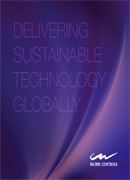
Water Treatment
Used in Water Treatment Plants and RO systems helps to monitor and control the plant remotely, detect equipment failures and prepare preventive maintenance procedures resulting in more efficient operations

In 2003, 1.6 million deaths were estimated to be attributable to unsafe water and sanitation according to the WHO. Despite a global programme to address this problem, an estimated 780 million still lacked safe drinking water in 2010. In many developing countries the bulk of domestic and industrial wastewater is discharged without any treatment or after primary treatment only. In Latin America, only about 8% of wastewater collected passes through treatment plants, with Venezuela (the poorest performer) discharging 97% its raw sewage directly into the environment. Most of sub- Saharan Africa is without wastewater treatment.
Developed nations enjoy the health, economic and environmental benefits of an extensive network of drinking water, wastewater and storm water infrastructure. However, many of those systems are becoming antiquated and now require investment to repair decayed structures and install modern monitoring, control and maintenance technology.
Water Treatment Manages the Concentration of Contaminants

Many countries apply stringent regulations to the purification of drinking water and the discharge of wastewater into the environment. A range of water treatment processes are used to ensure appropriate quality is maintained for each specific end use. These may include drinking water, distilled and de-ionised water for scientific and medical uses, input for industrial processes or wastewater for discharge back into the environment without causing adverse ecological impact. The goal of all water treatment processes is to manage the concentration of contaminants so the water becomes fit for its desired end use. Monitoring levels of contaminants is essential.
Water treatment plants treat ground water, surface water or sea water, either to produce potable water for public consumption or less purified water for industrial processes. The processes used in water treatment facilities may be mechanical, chemical or biological and include sedimentation, filtration, chlorination, disinfection and coagulation. Equipment used in these processes includes: water filters, ozone generators, oil and water separators, screening equipment, sludge treatment equipment and many more. A wastewater discharge permit is typically required when the treatment of the raw water results in a discharge of wastewater (e.g. backwash) to surface water and evidence of contamination levels will then be required.
Drinking Water Treatment

This aims to produce water pure enough for human consumption. The methods used vary according to the location and the nature of the water being processed. Substances that are removed during the process of drinking water treatment include suspended solids, bacteria, algae, viruses, fungi, minerals (such as iron, manganese and sulphur) and other chemical pollutants such as fertilisers. Reverse Osmosis (RO) plants and Multi-Stage Flash distillation (MSF) plants are used for desalination to convert seawater to drinking water. To ensure quality at the tap, it is common practice to have residual disinfectants in the treated water in order to kill any bacteriological contamination during distribution. Minerals may also be added to aid safe distribution. Again, the levels of impurities in the water must be monitored at all times.
Industrial Water Treatment
Almost every industrial process uses water. Heating and cooling play an important part in many industrial processes and water is often used for heat transfer in boilers and cooling towers. Industrial users also need water for washing, drinking and for firefighting. After agriculture, industrial water treatment is the largest consumer of water. There are two main reasons for the treatment of that water:
- Removal of contaminants to make the processes the water is used in more efficient and to minimise damage to plant
- Removal of pollutants from water discharged to the environment (500,000 tons of pollutants pour into lakes and rivers each day in the US alone).
One common way in which treating industrial water supplies can minimise damage to plant is by reducing corrosion in low pressure boilers caused by dissolved oxygen, acidity and excessive alkalinity. Water treatment aims to remove the dissolved oxygen and maintain the appropriate pH and alkalinity levels in the boiler. Without effective water treatment, a cooling water system can suffer from scale formation, corrosion and fouling and may become a breeding ground for harmful bacteria such as those that cause Legionnaires’ disease. All of this reduces efficiency, shortens plant life and makes operations unreliable and unsafe.
Sewage and Wastewater Treatment
Sewage is generated by residential, institutional, commercial and industrial establishments. It includes household waste liquid from toilets, baths, showers and kitchen sinks that is disposed of via sewers. In many areas, sewage also includes liquid waste from industry and commerce. The separation of household waste into greywater and blackwater is becoming more common in the developed world, with greywater being permitted to be used for watering plants or recycled for flushing toilets. Biological processes are employed in the treatment of wastewater and may include aerated lagoons, activated sludge or slow sand filters.
Sewage can be treated close to where it is created, in a decentralised system such as a septic tank, biofilter or aerobic treatment system. Alternatively, a centralised system can be built in which the sewage is transported via a network of pipes and pump stations to a municipal treatment plant. Sewage collection and treatment is typically subject to local, state and federal regulations and standards, while industrial sources of wastewater often require specialised treatment processes.
Pacific Controls Managed Services for Water Treatment Plants
In water treatment plants, it is essential to monitor the key parameters to ensure that water quality matches the required specification, as lack of maintenance can cause contamination with serious consequences. Documentation of trends and historical data are also required not only to fulfil legal obligations but also to ensure that any problems are identified and resolved in a timely manner.
Pacific Controls ICT Enabled Managed Services for Business Process Integration can be used in water treatment plants and RO systems to help operations and maintenance personnel to monitor and control the plant remotely, to detect equipment failures and to prepare preventive maintenance procedures that will result in more efficient operations. The services will predict future failures before they occur and coordinate pre-emptive maintenance.
Real-time data is collected and stored in Pacific Controls Galaxy platform, which is designed with an open architecture for ease of integration with the supplier’s existing systems. The Pacific Controls data panels can collect information from proprietary systems and can easily be installed in older plants. Gbots can be used to control the plants remotely. Historical data is stored for easy retrieval and reports for regulators can be produced automatically at the appropriate time.
Benefits for Water Treatment Equipment Suppliers
Using Pacific Controls Managed Services for Critical Assets Monitoring allows manufacturers of water treatment plants to create a comprehensive database of information for their entire portfolio of installed equipment. The system unifies all of the data retrieved, making it comparable, and uses artificial intelligence, data mining techniques, trend prediction and modelling to deliver meaningful results in a range of dashboards and reports. The service brings long-term benefits as it will assist in delivering higher value to customers and by positioning the product in a premium quality market space.
Suppliers of water treatment plant and RO systems can use Pacific Controls Managed Services for Critical Assets Monitoring to add depth to their service offering. They can offer maintenance and monitoring services cost-effectively which will help them to develop a long-term relationship with their customers.
The accessibility of facts and figures from real time monitoring is extremely valuable in analysing performance, planning developments and designing future systems. By storing information from a diverse range of equipment on a single platform, analysis across interdependent parameters becomes possible at a press of button.
Benefits for Water Companies and Local Authorities
The data from multiple sensors installed in water treatment plants is collated at the Pacific Controls GCCC, where it can be analysed on the cloud computing platform to generate information that allows the continuous commissioning of water treatment plants, the swift correction of faults and also identifies areas for improvement. This generates savings and makes the data visible and verifiable allowing the water supplier to offer an unprecedented level of transparency and accountability.
Managing routine monitoring and maintenance from a single point enables more focus on core activities for water companies. Remote troubleshooting using Gbots to identify the causes of problems and, in some cases, to resolve them remotely streamlines maintenance.
The service is interoperable with existing software and enterprise systems. Data can be imported into the enterprise resource planning system (ERP) so that decision makers and plant managers have instant access to both detailed and high-level data about plant operations. Using Pacific Controls managed services to monitor water treatment plants through a unified platform outsources resource-consuming processes and reduces staff costs.

